L
labellum: The labellum of Cattleya dowiana is very showy.
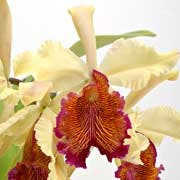
labellum (lah-BEL-lum) The lip or modified petal of an orchid flower.
labiatus, -a, -um (lah-bee-AY-tus) Large-lipped; having a lip; labiate.
labyrinthiformis, -e (lab-i-rin-thee-FORM-iss) With intricate winding lines or passages; labyrinthine.
Lacaena (la-SEE-na) The two epiphytic species in this genus are native to Central America. Lindley established the genus in 1843, deriving the generic name from the Greek word Lakaina. The reasoning is not clear, although this is an alternative name for Helen of Troy.
laceratus, -a, -um (la-ser-RAY-tus) Torn; irregularly cleft or cut; lacerate.
laciniatus, -a, -um (la-sin-ee-AY-tus) Slashed; cut into narrow pointed segments; laciniate.
lactescens (lak-TESS-senz) Containing milk or a milklike substance; lactescent.
lacunosus, -a, -um (lak-yew-NO-sus) Having holes or empty places; deeply pitted; lacunose.
Laelia (LAY-lee-a) A genus of showy epiphytic orchids from tropical America. Related to Cattleya and Epidendrum, it was described by Lindley in 1831, the name obscure but possibly dedicated to Laelia, one of the Vestal Virgins.
Laeliocattleya (lay-lee-oh-KAT-lee-a) A hybrid genus between Laelia and Cattleya created in 1863.
Laeliopsis (lay-lee-OP-siss) A monotypic epiphytic genus from the West Indies. It was established in 1853 by Lindley, the name alluding to the similarity of the species to the members of the genus Laelia. The species are now included in the genus Broughtonia.
laevigatus, -a, -um (lay-vig-AY-tus) Having a smooth, polished surface.
lamella (la-MEL-la) A thin flat plate or laterally flattened ridge; (pl. lamellae)
lamellate (LAM-el-layt) Provided with lamellae.
lamina (LAM-in-ah) The expanded portion of a leaf or floral segment. (See blade)
laminatus, -a, -um (lam-i-NAY-tus) Covered with plates or scales; laminated.
lanceolata: Sacoila lanceolata has a spear-shaped lip.
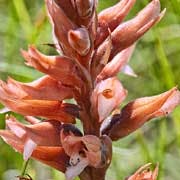
lanceolatus, -a, -um (lan-see-oh-LAY-tus) Shaped like the head of a lance; spear-shaped; narrow and tapering toward the apex or toward each end; lanceolate.
Lanium (lan-EE-um) A small epiphytic genus of two or more species native to northern South America. Lindley described the genus in 1841, coining the generic name from the Greek word for "wool" to denote the pubescens on the inflorescences and flowers.
Lankesterella (lank-es-ter-ELL-ah) A genus of 20 species of tropical American (chiefly Brazil) miniature epiphytic orchids. Related to Spiranthes, it was described by Oakes Ames in 1923 and dedicated to Charles H. Lankester, an ardent English amateur plantsman domiciled in Costa Rica.
lanuginosus, -a, -um (lan-oo-jin-OH-sus) Woolly or cottony; covered with soft, downy hairs; lanuginose.
lasioglossus, -a, -um (lay-zee-oh-GLOSS-us) Woolly tongued; having a rough or hairy lip.
laterialis, -e (la-ter-AY-lis) On or at the side of; lateral.
lath house (lath hous) A lattice-work structure that provides broken shade for orchids grown outdoors in warm or frost-free climates or seasons.
latex (LAY-teks) The milky sap found in some plants.
latifolius, -a, -um (lat-i-FOH-lee-us) Broad-leaved.
latilabrus, -a, -um (lat-i-LAY-brus) Broad-lipped.
lax (laks) Open or loose, not dense.
laxus, -a, -um (LAKS-us) Loose or open; lax.
lead: A new lead on a Cymbidium hybrid.
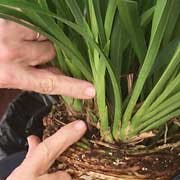
lead (leed) A young, new vegetative growth.
leaflet (LEEF-let) One part of a compound leaf; secondary leaf.
leaf-stalk (LEEF-stawk) The stem of a leaf; petiole.
lectotype (lek-TOE-type) A specimen chosen by subsequent workers in taxonomy when no holotype was designated or when the original holotype was lost or destroyed.
legitimate name (LEK-toe-type) A name that is in accordance with the articles of the International Codes of Nomenclature.
Lehmann, F.C. (1850—1903) Renowned Neotropical plant collector in Colombia, Ecuador and Central America with a special interest in orchids, commemorated in numerous orchids including Pescatorea lehmannii.
Lemboglossum (lem-boh-GLOSS-um) A primarily Mexican genus of 14 species of showy epiphytes formerly included in Odontoglossum. Halbinger established the genus in 1985, deriving the name from two Greek words meaning "boat" and "tongue," possibly to describe the callus tissue on the lip. Now synonymous with Rhynchostele.
lenticularis, -e (len-tik-yew-LAY-ris) Lentil-shaped; lens-shaped; lenticular.
lentiginosus, -a, -um (len-tij-in-OH-sus) Freckled; lentiginose.
Leochilus (lee-oh-KYE-luss) A genus of 10 species of dwarf epiphytic orchids from the American tropics allied to Oncidium. It was described by Knowles and Westcott in 1838, the name derived from the Greek meaning ecallose lip, in reference to the smooth lip of the flower.
leonis (lee-OH-niss) Of a lion, in the sense of strong, stout, leonine.
leopardinus, -a, -um (lee-oh-par-DYE-nus) Tawny, or conspicuously spotted like a leopard.
Lepanthes (leh-PAN-theez) A genus of 100 or more species of small-flowered dwarf epiphytic orchids of tropical America. Related to Pleurothallis and Masdevallia, it was founded by Swartz in 1799, the name referring to the tiny scalelike flowers.
Lepanthopsis (leh-pan-THOP-siss) A genus of 40 species of dwarf epiphytic orchids from tropical America, related to and resembling Lepanthes as its name implies. It was described by Oakes Ames in 1933.
lepidotus, -a, -um (le-pi-DOH-tus) Covered with small scurfy scales; lepidote.
lepidus, -a, -um (LEP-id-us) Neat, pretty, pleasing; graceful; elegant.
leptosepalus, -a, -um (lep-toh-SEP-al-us) Having slender sepals.
Leptotes (lep-TOH-teez) A genus of three species of epiphytic orchids from Brazil and Paraguay. Related to Laelia, it was described by Lindley in 1833, the name referring to the slender leaves.
leucochilum: Paphiopedilum leucochilum has a white lip.
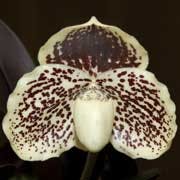
leucochilus, -a,-um (lew-ko-KYE-liss) White-lipped.
Leucohyle (lew-ko-HYE-lee) The four epiphytic species in this genus range from Panama south to Brazil. Klotzsch described the genus in 1834, deriving the generic name from two Greek words meaning "white" and "wool," in reference to the white hairs on the inflorescence.
leucorrhodus, -a, -um (lew-ko-ROH-dus) Rosy-white.
ligneous (LIG-nee-us) Woody.
ligulatus, -a, -um (lig-yew-LAY-tus) Strap-shaped; ligulate.
liguliform (lig-yu-LIH-form) Strap-shaped
limb (lim) The expanded portion of any petal, lip or leaf.
lilacina: Masdevallia lilacina has lilac-colored flowers.
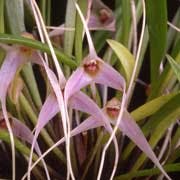
lilacinus, -a, -um (lye-la-SYE-nus) Like lilac in color or form.
limbatus, -a, -um (lim-BAY-tus) Having a distinct border of some other color; limbate.
Linden, Jean Jules (1817—1898) Famous explorer and Belgian horticulturist responsible for the introduction and popularization of numerous orchids, producer of the monumental illustrated works Pescatorea (1854—1860) and Lindenia (1885—1906).
Lindley, John (1799—1865) An eminent English botanist and orchidologist whose great contributions did so much to establish the basic knowledge of the orchid family; among his many works are Orchidearium Sceletos (1826), Genera and Species of Orchidaceous Plants (1830—1840), Sertum Orchidaceum (1837—1842), and Folia Orchidacea (1852—1859).
linearis, -e (lin-e-AY-ris) Long and narrow, with sides nearly parallel, like a blade of grass; linear.
lineatus, -a, -um (lin-ee-AY-tus) Lined; bearing thin parallel stripes; lineate.
linguiformis, -e (ling-gwee-FOR-miss) Tongue-shaped; linguiform.
lingulatus, -a, -um (ling-u-LAY-tus) Tongue-shaped; lingulate; ligulate.
linkage map (LINK-ij map) Delineation of the relative position of the genes on the chromosome.
lip (lip) See labellum
Listera (LISS-ter-a) A genus of 20 species of mostly dwarf terrestrial orchids found throughout the Northern Hemisphere, commonly called "twayblades." It was founded in 1813 by Robert Brown, the name commemorating Dr. Martin Lister (1638—1711), an English physician and naturalist.
lithophyte (LITH-oh-fyte) A plant that grows on rocks.
lithophytic (lith-oh-FIT-ik) Pertaining to a lithophyte; growing on rocks.
lividus, -a, -um (LIV-id-us) Lead-colored; bluish-gray; livid.
lobatus -a, -um (lo-BAY-tus) Furnished with lobes; lobed; lobate.
Lobb, Thomas (1811—1894) The younger of two brothers who collected plants for James Veitch & Sons, he traveled widely in India, Burma, Java, Malaya, Borneo, and the Philippines, discovering many new and valuable orchid species; he is commemorated in Bulbophyllum lobbii.
Lobb, William (1809—1863) The older of two brothers who collected plants for James Veitch & Sons from 1840 to 1857, he journeyed chiefly in South America, but later went to California, where he remained until his death.
lobe (lohb) Any division or segment of an organ such as a leaf, petal, etc.
lobed (lohb d) Furnished with a lobe or lobes.
lobulate (LOB-yew-layt) Furnished with lobules; having small lobes.
lobule (LOB-yewl) A small lobe.
Lockhart, David (?—1846) The first superintendent of the Botanical Gardens in Trinidad from 1818 to 1846, and a plant collector in Africa and Trinidad, his name is commemorated in the genus Lockhartia.
Lockhartia (lok-HART-ee-ah) A genus of 25 species of epiphytic orchids from the American tropics, related to Oncidium and commonly called the "braided orchid" because of the the arrangement of the leaves. It was described in 1827 by Hooker in compliment to David Lockhart.
locule (LOK-yewl) Compartment or cell of a pistil or anther.
locus, -i (LOH-kus) The position of a gene on the chromosome.
longicollis, -e (lon-jee-KOL-liss) Having a long neck.
longicornu (lon-jee-KOR-noo) Having a long horn.
longifolius, -a,-um (lon-jee-FOH-lee-us) Long-leaved.
longiscapus, -a, -um (lon-jee-SKAY-pus) Having a long scape or flower stalk.
loratus, -a, -um (lor-AY-tus) Strap-shaped; lorate.
Low, Hugh (1824—1904) Founder of the firm of Hugh Low & Co. of Clapton, London, and father of Rajah Sir Hugh Low of Sarawak, he collected orchids in Borneo, Burma and other countries of Asia.
lucid (LEW-sid) Shining, referring to the surface of an organ.
Luisia (loo-EEZ-ee-ah) A genus of 40 species of Asian epiphytic orchids with terete leaves and congested inflorescences. Closely related to Vanda, it was founded by Gaudichaud in 1826 and dedicated to Don Luis de Torres, a Spanish botanist of the nineteeth century.
lunatus, -a, -um (loo-NAY-tus) Crescent-shaped; lunate.
luridus, -a, -um (LOO-rid-us) Dismal-colored; yellowish brown; lurid.
luteolus, -a, -um (loo-tee-OH-lus) Pale yellow; yellowish.
luteo-purpureus, -a, -um (LOO-tee-oh-pur-PUR-ee-us) Yellowish purple or yellow and purple.
luteus, -a, -um (LOO-tee-us) Golden-yellow; luteous.
lutescens (loo-TESS-sens) Yellowish; becoming yellow; lutescent.
Lycaste (lye-KASS-tee) A genus of 25 species of epiphytic, or semiterrestrial, orchids of tropical America, described by Lindley in 1843 and dedicated the beautiful daughter of Priam, last king of Troy.
lyrate (LYE-rayt) Divided transversely into several lobes, the smallest at the base becoming gradually larger toward the end of the leaf.









